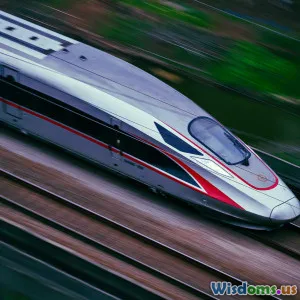
Inside A Day On An All Electric Bus Route
8 min read Explore the daily operations, technology, and benefits behind an all-electric bus route transforming urban transit. (0 Reviews)
Inside A Day On An All-Electric Bus Route
Urban transportation is undergoing a quiet revolution. As cities worldwide grapple with emissions, noise pollution, and sustainability goals, electric buses are stepping up as powerful agents of change. But what truly happens on an all-electric bus route from dawn till dusk? How do these vehicles perform in the hands of drivers, grapple with daily operational demands, and impact city life? This article takes you on a comprehensive ride, exploring every nuance of a full day behind the wheel and beneath the surface of an all-electric bus route.
Morning Kickoff: Start of Route and Fresh Technology
At 5:30 AM, the depot buzzes with activity. Unlike traditional diesel garages filled with fuels and fumes, this facility showcases sleek electric buses lined up at charging bays. These buses, like the Volvo 7900 Electric or Proterra Catalyst models, have fully charged batteries thanks to overnight charging systems – either using depot fast chargers delivering up to 150 kW or high-power pantograph chargers.
The Driver’s Perspective
Elena, a seasoned bus driver on the route, notes, "Driving an electric bus feels fundamentally different. The acceleration is smooth and quiet, and there's instant torque. It requires less gear shifting, so it’s less physically demanding." Drivers undergo specialized training to understand regenerative braking, energy management, and route-specific battery considerations.
Charging Infrastructure
Deploying an all-electric route isn’t just about the buses—it's about power. Innovative charging infrastructure, often a combination of slow overnight charges and quick in-route top-ups, is critical. Cities like Shenzhen have pioneered wireless charging pads installed at bus stops, reducing downtime and extending operational range.
Mid-Morning In-service Operations: Efficiency and Performance
As the city streets come alive, Elena’s bus weaves through morning commuters, silently gliding along the route. Electric buses reduce noise pollution dramatically, cutting noise levels inside and outside the vehicle by up to 10 decibels compared to diesel counterparts. This can improve public transport perceptions in urban centers.
Monitoring Energy Consumption
Onboard telematics systems provide real-time data on battery health, energy consumption, and range estimates. For instance, a New York City battery-electric bus traveling its standard 30-40 mile route consumes roughly 110-120 kWh, significantly less than the equivalent energy embedded in diesel fuel.
Dealing with Route Topography
Routes with steep hills or heavy stop-and-go traffic highlight the value of electric propulsion. Regenerative braking systems harvest kinetic energy during deceleration to recharge batteries, reducing total energy usage by approximately 20-30%. This is especially beneficial on routes with frequent stops.
Midday Challenges and Solutions
Over half of electric buses operate in temperate climates but handling extreme conditions is increasingly vital. Heat can degrade battery performance, while cold affects energy efficiency. On a particularly hot day, Elsa, the route dispatcher, keeps a close eye on battery thermal management systems.
"The system automatically adjusts coolant flows to maintain optimal temperatures," Elsa explains. "This ensures the battery doesn’t overheat, extending service life and safety."
Charging Mid-Shift
Some routes incorporate strategically placed rapid chargers enabling short 7-10 minute charges during layovers. This "opportunity charging" approach is common in European cities like London and Paris, extending operational range without full battery swaps.
Environmental Impact
Switching from diesel to electric has cut the route’s carbon footprint by roughly 80%, according to a report by the International Council on Clean Transportation (ICCT). This translates into thousands of tons of CO2 avoided annually and substantially improved urban air quality.
Afternoon Passenger Experience and Community Impact
Riders consistently report quieter, smoother rides. Accessibility also improves – electric buses frequently include low-floor designs and advanced climate control systems that maintain consistent cabin temperatures.
Real-world Benefits
In Los Angeles, the first year following an all-electric pilot route saw a 12% increase in public transit ridership along the corridor. Passengers cited noise reduction and air quality improvements as key factors.
End-of-Day Wrap-Up: Maintenance and Future Prospects
Post-shift, the buses return to the depot, plugging into chargers for overnight power replenishment. Maintenance routines change – fewer engine parts mean lower upkeep costs and reduced mechanical failure risk.
Insights from transit authorities suggest electric buses display up to 40% lower lifecycle costs compared to diesel models when accounting for fuel, maintenance, and emissions-related expenses.
Growing Adoption
With governments worldwide investing billions into zero-emission transit initiatives, electric bus fleets are rapidly expanding. China leads with over 400,000 electric buses in service as of 2023, while the EU and the US accelerate procurement with ambitious sustainability targets.
Conclusion: Driving Towards a Greener Urban Future
Spending a day on an all-electric bus route reveals more than just the mechanics of battery-powered vehicles—it uncovers a transformative approach to urban mobility. Enhanced driver comfort, reduced environmental footprint, quieter streets, and improved community health are all tangible benefits reshaped by electrification.
While challenges surrounding charging infrastructure, battery lifespan, and grid capacity remain, ongoing innovation and policy support promise a scalable model for cities worldwide. As electric buses continue to replace aging diesel fleets, they offer a compelling blueprint for sustainable, efficient, and people-friendly public transport.
In short, the all-electric bus route is not just a line on a map; it’s a pathway to more livable cities and a climate-friendly future.
References:
- International Council on Clean Transportation (ICCT), "Global EV Outlook," 2023
- Los Angeles Metro Transit Studies, 2022
- Shenzhen Electric Bus Development Reports
- Volvo and Proterra Technical Documentation
Rate the Post
User Reviews
Popular Posts















